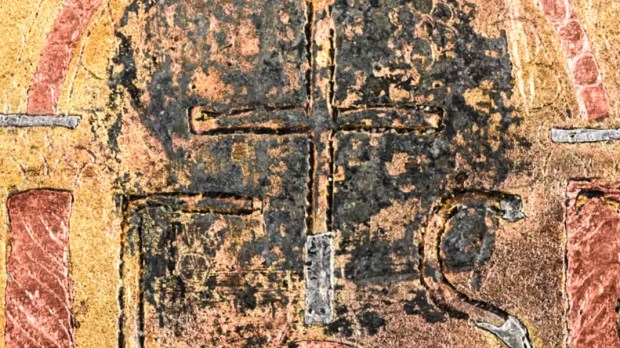While working with a metal detector at an archaeological site in Hippos (Sussita), northern Israel, Dr. Bradley Bowlin discovered a small brass weight that dates back to the Byzantine era. The object was given to Dr. Alexander Iermolin, director of the Conservation Laboratory at Haifa University’s Archaeological Institute, who discovered a strange dark stain in the shape of a cross on the obverse side.
JPost has lead archaeologist, Dr. Michael Eisenberg explaining the significance of the discovery:
“… the stain was made deliberately to conceal a cross, a Christian religious symbol used by the Christian population, so that they could continue to use the weight in their contacts with the new Muslim rulers. This is the first time that we have found a weight featuring this type of concealed element.”
Hippos was a 2nd-century settlement that became a major city during the Roman and Byzantine periods. The entire city was destroyed by an earthquake in 749, when it was under the rule of the first Islamic caliphate of the Umayyad administration. The site of Hippo, in Sussita National Park, has been undergoing excavation since 2000.
Eisenberg went on to explain that their first reaction to the stain was to clean it off, but the unusual shape gave them pause. Instead, they sent the brass weight to an expert in ancient metallurgy, Prof. Sariel Shalev of the University of Haifa, who determined the design was produced deliberately.
“The melting temperature of the paste was around one-third the melting temperature of the other components of the weight. Since people during this period had a strong mastery of craftsmanship, it was clear that the stain had been made deliberately. Moreover, small sections of the silver cross had been chiseled out in order to ensure that the weight of the object remained unchanged. In short, there was no chance that the stain was coincidental,” Shalev concluded.
Researchers have long considered the early Muslim rule to have been rather tolerant toward other religions. Historical records and testimonies show that Christians were left in relative peace to worship as they pleased. Eisenberg suggested that this discovery is evidence that their tolerance had hard limits:
“The cross was deliberately covered by church officials during the early Islamic period so that they could continue to use the weight, together with other weights in the official city weights set kept at the central church in Hippos, as well as in their contacts with the Muslim administration in Tiberias. This situation offers a precise illustration of the dividing line during this period of regime change between considerable religious and cultural freedom and the point when a Muslim official might be forced to hold an object displaying an overtly Christian emblem,” Eisenberg said.

